|
USS Monitor Homepage
A Union Navy Warship History
USS Monitor Homepage
Father of the Monitor Class
USS Monitor
USS Monitor was a technological marvel for its time. She was powered by
steam alone and was the first American warship with no masts or sails. Barely one foot of her deck was visible, with all storage,
machinery, berthing and working areas below the water line. The ship's most novel feature was its revolving turret in the
middle of the ship. The turret boasted two 11-inch Dahlgren smoothbore cannons. Constructed almost exclusively of iron, the
ship was heavy and thereby required it to avoid shallow water because it could become stuck and quickly become a target.
Designed by Swedish-American engineer John Ericsson, when it was constructed,
the USS Monitor represented a radical departure from traditional warship design. This Union vessel was powered by steam alone
and was the first American warship with no masts and sails. With barely more than one foot of her deck visible, all
machinery, storage, working, and berthing areas were below the water line.
The vessel was constructed almost exclusively of iron and was heavily armored. A five-foot high, six-inch
thick armor belt encircled the vessel at the water line for protection during battle. Perhaps the ship's most novel feature
was its revolving turret. Located near the middle of the ship, it was 9 feet high, 22 feet in diameter, and housed two 11-inch
Dahlgren smoothbore cannon.
The Monitor was launched from Continental Iron Works, Greenpoint, Long Island (New York City) on January
30, 1862. Less than two months later, she encountered the larger and more heavily armed Confederate ironclad, Virginia, in
the infamous Battle of Hampton Roads. While neither ship suffered much damage during the battle, their fight marked the first
time iron ships clashed in naval warfare and signaled the end of the era of wooden warships.
Shortly after midnight on December 31, 1862, while being towed by the USS Rhode Island to Beaufort, North
Carolina, the Monitor sank in a gale off Cape Hatteras. Its final resting place was designated as the nation’s first
national marine sanctuary in 1975.
| CSS Virginia v. USS Monitor |
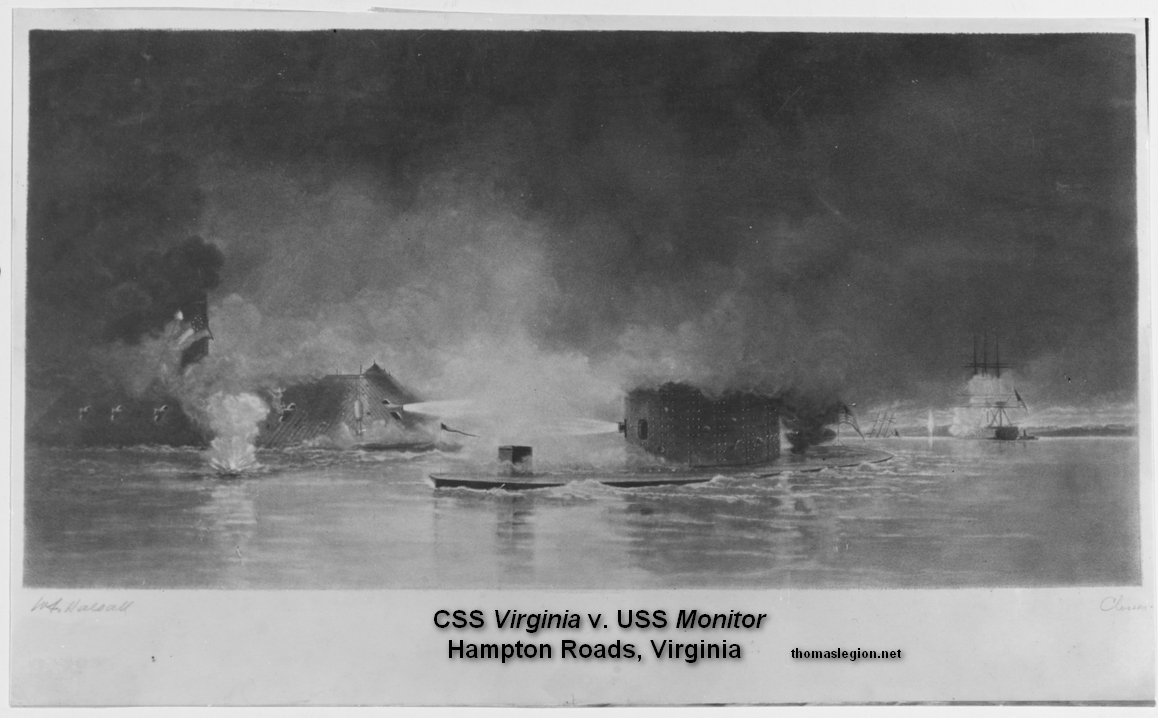
|
| Battle of the Ironclads Monitor and Virginia (ex Merrimack) |
| USS Monitor |
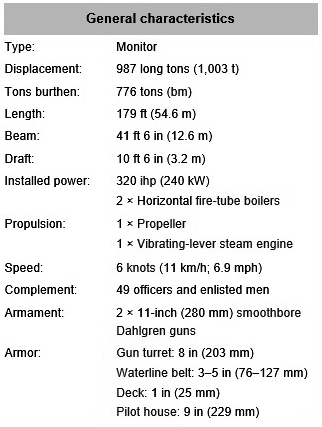
|
| USS Monitor Characteristics |
Battle of Hampton Roads
The March 9, 1862, battle between the Monitor and the Merrimack (CSS Virginia)
during the American Civil War (1861-65) was history’s first duel between ironclad warships. The engagement, known as
the Battle of Hampton Roads, was part of a Confederate effort to break the Union blockade of Southern ports, including Norfolk
and Richmond, Virginia, that had been imposed at the start of the war. Though the battle itself was inconclusive, it began
a new era in naval warfare.
The CSS Virginia was originally the USS Merrimack, a 40-gun frigate launched
in 1855. The Confederates captured it and covered it in heavy armor plating above the waterline. Outfitted with powerful guns,
the Virginia was a formidable vessel when the Confederates launched her in February 1862. On March 8, the Virginia sunk two
Union ships and ran one aground off Hampton Roads.
The next day, the USS Monitor steamed into the Chesapeake Bay. Designed
by Swedish engineer John Ericsson, the vessel had an unusually low profile, rising from the water only 18 inches. The flat
iron deck had a 20-foot cylindrical turret rising from the middle of the ship; the turret housed two 11-inch Dahlgren guns.
TheMonitor had a draft of less than 11 feet so it could operate in the shallow harbors and rivers of the South. It was commissioned
on February 25, 1862, and arrived at Chesapeake Bay just in time to engage the Virginia.
The battle between the Virginia and the Monitor began on the morning of
March 9 and continued for four hours. The ships circled one another, jockeying for position as they fired their guns. The
cannon balls simply deflected off the iron ships. In the early afternoon, the Virginia pulled back to Norfolk. Neither ship
was seriously damaged, but the Monitor effectively ended the short reign of terror that the Confederate ironclad had brought
to the Union navy.
Both ships met ignominious ends. When the Yankees invaded the James Peninsula
two months after the battle at Hampton Roads, the retreating Confederates scuttled their ironclad. The Monitor went down in
bad weather off Cape Hatteras, North Carolina, at the end of the year. Though they had short lives, the ships ushered in a
new era in naval warfare.
After the famous duel, the Monitor provided gun support on the James
River for George B. McClellan’s Peninsular Campaign. By December 1862, it was clear the Monitor was no longer needed
in Virginia, so she was sent to Beaufort, North Carolina, to join a fleet being assembled for an attack on Charleston, South
Carolina. The Monitor served well in the sheltered waters of Chesapeake Bay, but the heavy, low-slung ship was a poor craft
for the open sea. The USS Rhode Island towed the ironclad around the rough waters of Cape Hatteras. Since December is a treacherous
time for any ship off North Carolina, the decision to move the Monitor could be considered questionable. As the Monitor pitched
and swayed in the rough seas, the caulking around the gun turret loosened and water began to leak into the hull. More leaks
developed as the journey continued. High seas tossed the craft, causing the ship’s flat armor bottom to slap the water.
Each roll opened more seams, and by nightfall on December 30, the Monitor was in dire straits.
The Monitor’s commander, J.P. Bankhead, signaled the Rhode Island
that he wished to abandon ship. The wooden side-wheeler pulled as close as safety allowed to the stricken ironclad, and two
lifeboats were lowered to retrieve the crew. Many of the sailors were rescued, but some men were terrified to venture onto
the deck in such rough seas. The ironclad’s pumps stopped working and the ship sank before 16 crew members could be
rescued.
Although the Monitor’s service was brief, it signaled a new era in
naval combat. The Virginia’s arrival off Hampton Roads terrified the U.S. Navy, but the Monitor leveled the playing
field. Both sides had ironclads, and the advantage would go to the side that could build more of them. Northern industry would
win that battle for the Union.
| USS Monitor History |
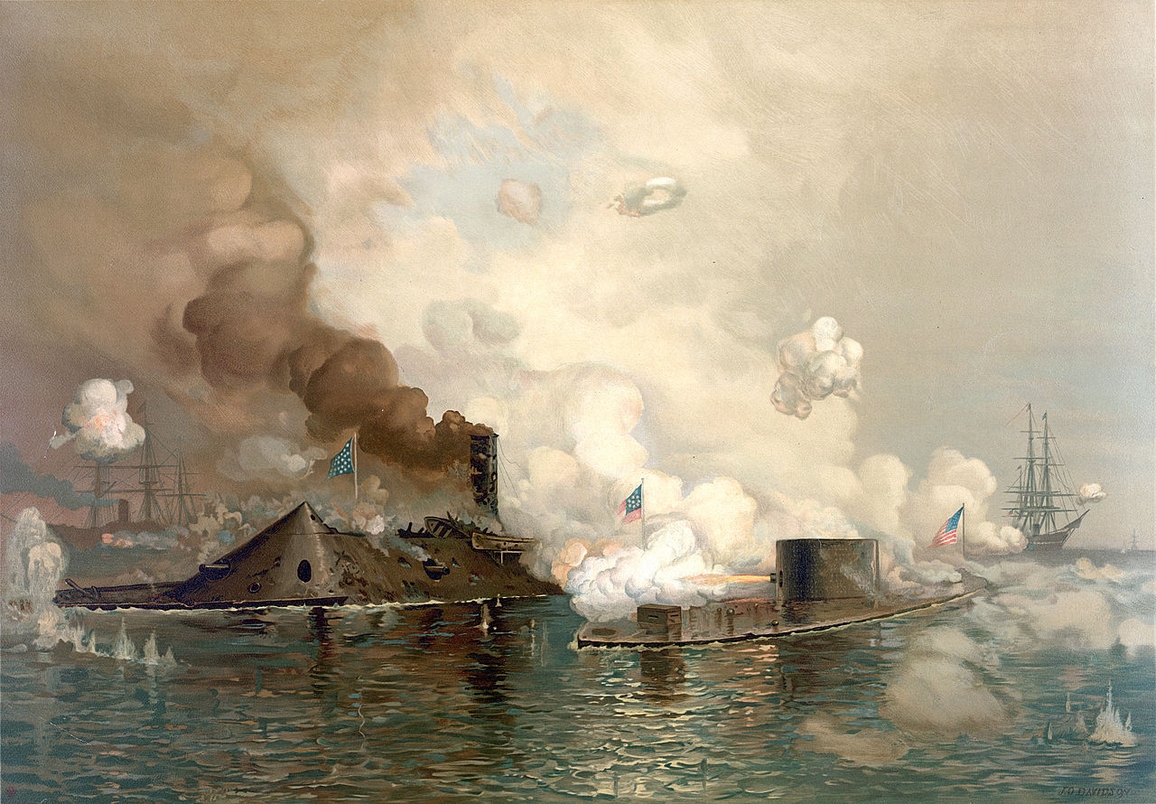
|
| USS Monitor engages CSS Virginia during Battle of Hampton Roads, VA. |
| USS Monitor |
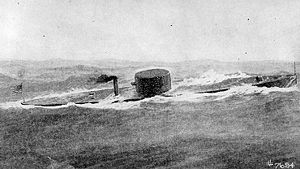
|
| USS Monitor |
| CSS Virginia (12 guns) and USS Monitor (2 guns) |
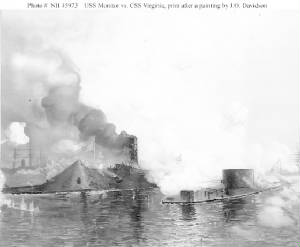
|
| CSS Virginia (12 guns) and USS Monitor (2 guns) |
Recommended
Reading: Ironclad, by Paul Clancy (Hardcover). Description: The
true story of the Civil War ironclad that saved the Union Navy only to sink in a storm--and its remarkable salvage 140 years
later. Ironclad tells the saga of the warship USS Monitor and its salvage, one of the most complex and dangerous in history.
The Monitor is followed through its maiden voyage from New York to Hampton Roads, its battle
with the Merrimack, and its loss off Cape
Hatteras. At the same time, author Paul Clancy takes readers behind the
scenes of an improbable collaboration between navy divers and cautious archaeologists working 240 feet deep. Clancy creates
a memorable, fascinating read, including fresh insights into the sinking of the Union ship and giving the answer to an intriguing
forensic mystery: the identities of the two sailors whose bones were found in the Monitor's recovered turret. Continued below…
Its one great
battle in the spring of 1862 marked the obsolescence of wooden fighting ships and may have saved the Union. Its terrible end in a winter
storm off Cape Hatteras
condemned sixteen sailors to a watery grave. And the recovery of its 200-ton turret in August 2002 capped the largest, most
complex and hazardous ocean salvage operation in history. In Ironclad, Paul Clancy interweaves these stories so skillfully
that the cries of drowning Union sailors sound a ghostly undertone to the cough of diesel generators and the clanging of compression-chamber
doors on a huge recovery barge. The din and screech of cannonballs on iron plating echo beneath the hum of electronic monitors
and the garbled voices of Navy divers working at the edge of human technology and endurance in water 240 feet deep.
Clancy studied
the letters and diaries of the Monitor's long-ago sailors, and he moved among the salvage divers and archaeologists in the
summer of 2002. John L. Worden, captain of the Monitor, strides from these pages no less vividly than the remarkable Bobbie
Scholley, the woman commander of 160 Navy divers on an extreme mission. Clancy writes history as it really happens, the improbable
conjunction of personalities, ideas, circumstances, and chance. The Union navy desperately needed an answer to the Confederacy's
ironclad dreadnought, and the brilliantly eccentric Swedish engineer John Ericsson had one. And 140 years later, when marine
archaeologists despaired of recovering any part of the Monitor before it disintegrated, a few visionaries in the U.S. Navy
saw an opportunity to resurrect their deep-water saturation diving program. From the breakneck pace of Monitor's conception,
birth, and brief career, to the years of careful planning and perilous labor involved in her recovery, Ironclad tells a compelling
tale of technological revolution, wartime heroism, undersea adventure, and forensic science. This book is must-reading for
anyone interested in Civil War and naval history, diving and underwater salvage, or adventures at sea.
Recommended
Reading: War, Technology, and Experience aboard the USS Monitor. Description: In a familiar story, the USS Monitor battled the CSS Virginia (the armored and refitted
USS Merrimack) at Hampton Roads in March of 1862. In War, Technology, and Experience aboard the USS Monitor, David A. Mindell
adds a new perspective to the story as he explores how mariners -- fighting "blindly" below the waterline -- lived and coped
with the metal monster they called the "iron coffin." Mindell shows how the iron warship emerged as an idea and became practicable,
how building it drew upon and forced changes in contemporary manufacturing technology, and how the vessel captured the nineteenth-century
American popular and literary imaginations. Continued below…
Combining technical,
personal, administrative, and literary analysis, Mindell examines the experience of the men aboard the Monitor and their reactions
to the thrills and dangers that accompanied the new machine. The invention surrounded men with iron and threatened their heroism,
their self-image as warriors, even their lives. Mindell also examines responses to this strange new warship by Nathaniel Hawthorne
and Herman Melville, who prophetically saw in the Civil War a portent of the mechanized warfare of the future. The story of
the Monitor shows how technology changes not only the tools but also the very experience of combat, generating effects that
are still felt today in the era of "smart bombs" and push-button wars. "We find new significance in the otherwise well-known
history of the Monitor. It is no longer the story of the heroic inventor and his impenetrable weapon thrusting themselves
upon a doubtful and conservative bureaucracy... It is no longer the story of a heroic battle and the machine's epic loss soon
after. Rather it is a story of people experiencing new machinery, attempting to make sense of its thrills, constrictions,
and politics, and sensing its power and impotence -- both in glory and frustration." -- from War, Technology, and Experience
aboard the USS Monitor. About the Author: David A. Mindell is Dibner
Associate Professor of the History of Engineering and Manufacturing in the Program in Science, Technology, and Society at
MIT. He has degrees in Electrical Engineering and Literature from Yale University
and a Ph.D. in the History of Technology from MIT. His research interests include the history of military technology, the
history of electronics and computing, and archaeology in the deep ocean. He is currently working on a history of feedback,
control, and computing in the twentieth century, and on locating and imaging ancient shipwrecks and settlements in the deep
regions of the Black Sea.
Recommended
Reading: Confederate Ironclad vs Union Ironclad: Hampton Roads
1862 (Duel). Description: The Ironclad
was a revolutionary weapon of war. Although iron was used for protection in the Far East
during the 16th century, it was the 19th century and the American Civil War that heralded the first modern armored self-propelled
warships. With the parallel pressures of civil war and the industrial revolution, technology advanced at a breakneck speed.
It was the South who first utilized ironclads as they attempted to protect their ports from the Northern blockade. Impressed
with their superior resistance to fire and their ability to ram vulnerable wooden ships, the North began to develop its own
rival fleet of ironclads. Eventually these two products of this first modern arms race dueled at the battle of Hampton Roads
in a clash that would change the face of naval warfare. Continued below…
Fully illustrated
with cutting-edge digital artwork, rare photographs and first-person perspective gun sight views, this book allows the reader
to discover the revolutionary and radically different designs of the two rival Ironclads - the CSS Virginia and USS Monitor
- through an analysis of each ship's weaponry, ammunition and steerage. Compare the contrasting training of the crews and
re-live the horrors of the battle at sea in a war which split a nation, communities and even families. About the Author: Ron
Field is Head of History at the Cotswold School in
Bourton-on-the-Water. He was awarded a Fulbright Scholarship in 1982 and taught history at Piedmont
High School in California
from 1982 to 1983. He was associate editor of the Confederate Historical Society of Great Britain, from 1983 to 1992. He is
an internationally acknowledged expert on US Civil War military history, and was elected a Fellow of the Company of Military
Historians, based in Washington, DC,
in 2005. The author lives in Cheltenham, UK.
Recommended
Reading: Union Monitor 1861-65. Description:
The first seagoing ironclad was the USS Monitor, and its profile has made it one of the most easily recognized warships of
all time. Following her inconclusive battle with the Confederate ironclad Virginia
on March 9, 1862, the production of Union monitors was accelerated. By the end of the year, a powerful squadron of monitor
vessels protected the blockading squadrons off the Southern coastline and was able to challenge Confederate control of her
ports and estuaries. Further technological advancements were included in subsequent monitor designs, and by the end of the
war the US Navy possessed a modern coastal fleet carrying the most powerful artillery afloat. This book covers the design,
development and operational history of the Union’s Monitor fleet.
Recommended
Reading: The Battle of Hampton
Roads: New Perspectives on the USS Monitor and the CSS Virginia (Mariner's Museum). Description: On March 8 and 9, 1862, a sea battle off the Virginia coast changed naval warfare forever. It began when the Confederate States Navy’s
CSS Virginia led a task force to break the Union blockade of Hampton Roads. The Virginia
sank the USS Cumberland and forced the frigate Congress to surrender. Damaged by shore batteries, the Virginia retreated, returning the next day to find her way blocked by the newly arrived
USS Monitor. The clash of ironclads was underway. Continued below…
After fighting
for nine hours, both ships withdrew, neither seriously damaged, with both sides claiming victory. Although the battle may
have been a draw and the Monitor sank in a storm later that year, this first encounter between powered, ironclad warships
spelled the end of wooden warships—and the dawn of a new navy. This book takes a new look at this historic battle. The
ten original essays, written by leading historians, explore every aspect of the battle—from the building of the warships
and life aboard these “iron coffins” to tactics, strategy, and the debates about who really won the battle of
Hampton Roads. Co-published with The Mariners’ Museum, home to the USS Monitor Center, this authoritative guide to the
military, political, technological, and cultural dimensions of this historic battle also features a portfolio of classic lithographs,
drawings, and paintings. Harold Holzer is one of the country’s leading experts on the Civil War.
Recommended
Reading: Civil War Ironclads: The U.S. Navy and Industrial Mobilization (Johns Hopkins
Studies in the History of Technology). Description: "In this impressively researched and broadly conceived study, William
Roberts offers the first comprehensive study of one of the most ambitious programs in the history of naval shipbuilding, the
Union's ironclad program during the Civil War. Perhaps more importantly, Roberts also provides
an invaluable framework for understanding and analyzing military-industrial relations, an insightful commentary on the military
acquisition process, and a cautionary tale on the perils of the pursuit of perfection and personal recognition." - Robert
Angevine, Journal of Military History "Roberts's study, illuminating on many fronts, is a welcome addition to our understanding
of the Union's industrial mobilization during the Civil War and its inadvertent effects on the postwar U.S. Navy." - William
M. McBride, Technology and Culture"
Recommended
Reading: Reign of Iron: The Story of the First Battling Ironclads, the Monitor and the Merrimack. From Publishers Weekly: The Monitor-Merrimack showdown may be one
of the Civil War’s most overhyped chestnuts: the two ships were by no means the first ironclads, and their long awaited
confrontation proved an anticlimactic draw, their cannon fire clanging harmlessly off each other’s hulls. Still, the
author of this lively history manages to bring out the story’s dramatic elements. Nelson, author of the Revolution at
Sea series of age-of-sail adventure novels, knows how to narrate a naval crisis. He gives a harrowing account of the Merrimack’s initial onslaught, in which it destroyed two wooden
Union warships in a bloody and chaotic battle the day before the Monitor arrived, and of the Monitor’s nightmarish final
hours as it foundered in a storm at sea. Continued below…
Equally arresting
is his retelling of the feverish race between North and South to beat the other side to the punch with their respective wonder
ships. He delves into every aspect of the ships’ innovative design and construction, and draws vivid portraits of the
colorful characters who crafted them, especially the brilliant naval architect John Ericsson, one of that epic breed of engineer-entrepreneurs
who defined the 19th century. The resulting blend of skillful storytelling and historical detail will please Civil War and
naval engineering buffs alike.
Recommended
Viewing: The First Ironclads - Into the Modern Era (DVD) (2008). Description: This is the story of the great vessels, the formidable
warships, the epic ironclads (early battleships), that changed forever naval ship design as well as naval warfare: the Monitor,
the Merrimack
(later renamed the Virginia)
and it presents a fascinating animated reconstruction of their epic battle during the American Civil War. Continued below...
The Battle
of Hampton Roads, aka Duel of the Ironclads, which made the world's navies tremble as well as obsolete, is handsomely depicted
in this video. The First Ironclads – Into the Modern Era is a welcome addition for the individual interested in the
Civil War, U.S. Naval Warfare, and shipbuilding and design. It also includes footage from aboard the world's most devastating
“sailing ironship” the HMS Warrior.
|

